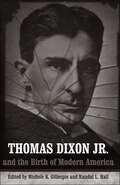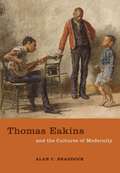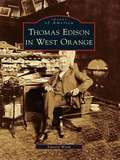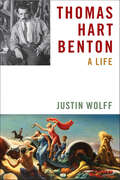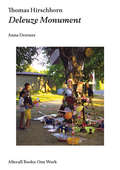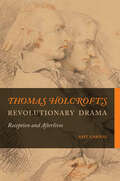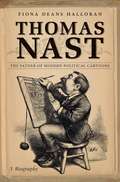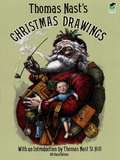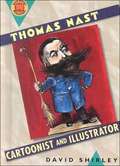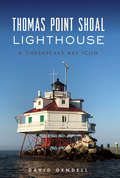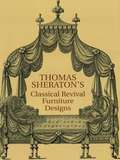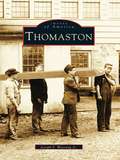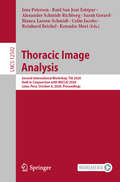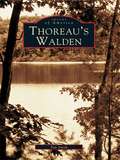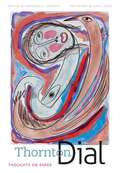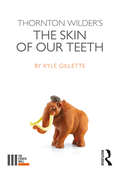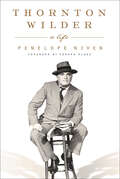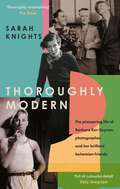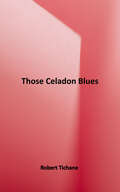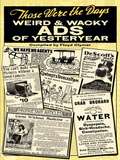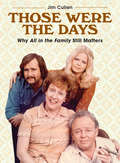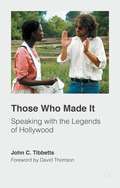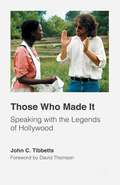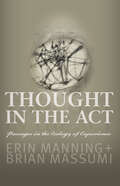- Table View
- List View
Thomas Dixon Jr. and the Birth of Modern America (Making the Modern South)
by Michele K. Gillespie Randal L. Hall"A sweeping yet rigorous analysis of Dixon and his work. The collection approaches the southern intellectual through multiple methodologies -- from literary theory and film studies to social history and religious studies. We get an exhaustive yet diverse perspective on Dixon's influence and legacy." -- Journal of American HistoryThomas Dixon Jr. (1864--1946), best remembered today as the author of the racist novels that served as the basis for D. W. Griffith's controversial 1915 classic film The Birth of a Nation, also enjoyed great renown in his lifetime as a minister, lecturer, lawyer, and actor. Although this native southerner's blatantly racist, chauvinistic, and white supremacist views are abhorrent today, his contemporary audiences responded enthusiastically to Dixon. In Thomas Dixon Jr. and the Birth of Modern America, distinguished scholars of religion, film, literature, music, history, and gender studies offer a provocative examination of Dixon's ideas, personal life, and career and in the process illuminate the evolution of white racism in the early twentieth century and its legacy down to the present. The contributors analyze Dixon's sermons, books, plays, and films seeking to understand the appeal of his message within the white culture of the Progressive era. They also explore the critical responses of African Americans contemporary with Dixon. By delving into the context and complexity of Dixon's life, the contributors also raise fascinating questions about the power of popular culture in forming Americans' views in any age. "An important and valuable addition to the literature on turn-of-the-century white supremacy." -- Journal of Southern History
Thomas Eakins and the Cultures of Modernity
by Alan BraddockThe Author demonstrates that Eakins's realistic portrayals of Spanish street performers, African Americans, and southern European immigrants embodied a modern worldview. Yet by exploring Eakins's struggle to visualize diversity amid the dislocating forces of his day mass immigration, Orientalism, tourism, commercial publishing, and the international circulation of ethnographic objects.
Thomas Edison in West Orange
by Edward WirthThomas Edison spent the second half of his life in West Orange, about 10 miles from New York City. There he built his last and largest laboratory, where he developed motion pictures, improved the phonograph, and built an international business empire, earning over half of his 1,093 patents. The five laboratory buildings housed over 100 experimenters busily engaged in invention and innovation. As they turned ideas into commercial products, Edison surrounded the laboratory with factories that employed over 4,000 workers. From the first days, staff photographers documented every aspect of life in this town within a town.
Thomas Hart Benton: A Life
by Justin WolffBorn in Missouri at the end of the nineteenth century, Thomas Hart Benton would become the most notorious and celebrated painter America had ever seen. The first artist to make the cover of Time, he was a true original: an heir to both the rollicking populism of his father's political family and the quiet life of his Appalachian grandfather. In his twenties, he would find his calling in New York, where he was drawn to memories of his small-town youth—and to visions of the American scene.By the mid-1930s, Benton's heroic murals were featured in galleries, statehouses, universities, and museums, and magazines commissioned him to report on the stories of the day. Yet even as the nation learned his name, he was often scorned by critics and political commentators, many of whom found him too nationalistic and his art too regressive. Even Jackson Pollock, his once devoted former student, would turn away from him in dramatic fashion. A boxer in his youth, Benton was quick to fight back, but the widespread backlash had an impact—and foreshadowed many of the artistic debates that would dominate the coming decades.In this definitive biography, Justin Wolff places Benton in the context of his tumultuous historical moment—as well as in the landscapes and cultural circles that inspired him. Thomas Hart Benton—with compelling insights into Benton's art, his philosophy, and his family history—rescues a great American artist from myth and hearsay, and provides an indelibly moving portrait of an influential, controversial, and often misunderstood man.
Thomas Hirschhorn: Deleuze Monument (One Work)
by Anna DezeuzeAn illustrated examination of one of Hirschhorn's “precarious” monuments, now dismantled. Part-text, part-sculpture, part-architecture, part-junk heap, Thomas Hirschhorn's often monumental but precarious works offer a commentary on the spectacle of late-capitalist consumerism and the global proliferation of commodities. Made from ephemeral materials—cardboard, foil, plastic bags, and packing tape—that the artist describes as “universal, economic, inclusive, and [without] any plus-value,” these works also engage issues of justice, power, and moral responsibility. Hirschhorn (born in Switzerland in 1957) often chooses to place his work in non-art settings, saying that he wants it to “fight for its own existence.” In this book, Anna Dezeuze offers a generously illustrated examination of Hirschhorn's Deleuze Monument (2000), the second in his series of four Monuments. Deleuze Monument—a sculpture, an altar, and a library dedicated to Gilles Deleuze—was conceived as a work open to visitors twenty-four hours a day, seven days a week. Part of the exhibition “La Beauté” in Avignon, Deleuze Monument was controversial from the start, and it was dismantled two months before the end of the exhibition after being vandalized. Dezeuze describes the chronology of the project, including negotiations with local residents; the dynamic between affirmation and vulnerability in Hirschhorn's work; failure and ”scatter art” in the 1990s; participatory practices; and problems of presence, maintenance, and appearance, raised by Hirschhorn's acknowledgement of “error” in his discontinuous presence on site following the installation of Deleuze Monument.
Thomas Holcroft’s Revolutionary Drama: Reception and Afterlives (Transits: Literature, Thought & Culture, 1650-1850)
by Amy GarnaiA key figure in British literary circles following the French Revolution, novelist and playwright Thomas Holcroft promoted ideas of reform and equality informed by the philosophy of his close friend William Godwin. Arrested for treason in 1794 and released without trial, Holcroft was notorious in his own time, but today appears mainly as a supporting character in studies of 1790s literary activism. Thomas Holcroft’s Revolutionary Drama authoritatively reintroduces and reestablishes this central figure of the revolutionary decade by examining his life, plays, memoirs, and personal correspondence. In engaging with theatrical censorship, apostacy, and the response of audiences and critics to radical drama, this thoughtful study also demonstrates how theater functions in times of political repression. Despite his struggles, Holcroft also had major successes: this book examines his surprisingly robust afterlife, as his plays, especially The Road to Ruin, were repeatedly revived worldwide in the nineteenth century.
Thomas Nast
by Fiona Deans HalloranThomas Nast (1840-1902), the founding father of American political cartooning, is perhaps best known for his cartoons portraying political parties as the Democratic donkey and the Republican elephant. Nast's legacy also includes a trove of other political cartoons, his successful attack on the machine politics of Tammany Hall in 1871, and his wildly popular illustrations of Santa Claus for Harper's Weekly magazine. Throughout his career, his drawings provided a pointed critique that forced readers to confront the contradictions around them. In this thoroughgoing and lively biography, Fiona Deans Halloran focuses not just on Nast's political cartoons for Harper's but also on his place within the complexities of Gilded Age politics and highlights the many contradictions in his own life: he was an immigrant who attacked immigrant communities, a supporter of civil rights who portrayed black men as foolish children in need of guidance, and an enemy of corruption and hypocrisy who idolized Ulysses S. Grant. He was a man with powerful friends, including Mark Twain, and powerful enemies, including William M. "Boss" Tweed. Halloran interprets Nast's work, explores his motivations and ideals, and illuminates Nast's lasting legacy on American political culture.
Thomas Nast's Christmas Drawings (Dover Fine Art, History of Art)
by Thomas NastSixty-six Yuletide illustrations -- almost all holiday drawings -- by one of America's foremost illustrators and the creator of the popular Santa Claus image. Finely detailed drawings of St. Nick, sleigh rides, reindeer, "The Night Before Christmas," North Pole, and more are all depicted in this seasonal collection.
Thomas Nast: Cartoonist and Illustrator
by David ShirleyDescribes the life of the young German immigrant who became a noted illustrator of magazines and a political cartoonist.
Thomas Point Shoal Lighthouse: A Chesapeake Bay Icon (Landmarks)
by David GendellFor centuries, the hard-packed shoal at Thomas Point menaced Chesapeake Bay mariners. Even after two separate stone towers were built on the shoreline, sailors continued to request a light at the end of the mile-long shoal. When a new lighthouse was finally approved in 1873, experts deemed its novel design too fragile for the location--it was built anyway. Long overdue and of an inappropriate design, the iconic Thomas Point Shoal Lighthouse was lit in November 1875 and continues to serve mariners. Thomas Point is the last Chesapeake Bay screwpile-style lighthouse in its original location and one of only twelve American lighthouses designated as a National Historic Landmark. Join Annapolis sailor David Gendell as he explores Thomas Point.
Thomas Sheraton's Classical Revival Furniture Designs
by Thomas SheratonElegant 18th-century style book that was immediately successfully in England, Russia, America, British India. Complete coverage of Sheraton's most important designs: clock cases, commodes, drawing tables, library steps, chairs, other items. 98 plates.
Thomaston (Images of America)
by Joseph F. Wassong Jr.Thomaston, a gateway to the Litchfield Hills and the Berkshires, is situated in the picturesque Naugauck River Valley. This town of Victorian charm grew as local industry developed. Today, it includes a population representing many occupations and nationalities and a mixture of urban and suburban culture. Thomaston reveals the history of this town and its people, including a nineteenth-century priest who is a candidate for sainthood in the Roman Catholic Church, the grandfather of a Nobel Prize-winning author, and a hero who was awarded the Medal of Honor for valor at Pearl Harbor. The first part of the book is designed as a guide for a walking tour of the downtown area.
Thoracic Image Analysis: Second International Workshop, TIA 2020, Held in Conjunction with MICCAI 2020, Lima, Peru, October 8, 2020, Proceedings (Lecture Notes in Computer Science #12502)
by Sarah Gerard Jens Petersen Kensaku Mori Colin Jacobs Bianca Lassen-Schmidt Raúl San José Estépar Alexander Schmidt-Richberg Reinhard BeichelThis book constitutes the proceedings of the Second International Workshop on Thoracic Image Analysis, TIA 2020, held in Lima, Peru, in October 2020. Due to COVID-19 pandemic the conference was held virtually. COVID-19 infection has brought a lot of attention to lung imaging and the role of CT imaging in the diagnostic workflow of COVID-19 suspects is an important topic. The 14 full papers presented deal with all aspects of image analysis of thoracic data, including: image acquisition and reconstruction, segmentation, registration, quantification, visualization, validation, population-based modeling, biophysical modeling (computational anatomy), deep learning, image analysis in small animals, outcome-based research and novel infectious disease applications.
Thoreau's Walden
by Tim SmithWalden Pond is a sublime place of peace and spirituality. Writer and philosopher Henry David Thoreau built a one-room house in 1845 and lived on the shores of the pond for two years, two months, and two days. It is this "experiment in independent living" that draws millions of people to visit the pond and to pay homage to the man sometimes called the father of American conservation. Situated in woodland outside the town of Concord, the pond and the town itself also evoke history on a grand scale. The Revolutionary War and the literary revolution of the mid-nineteenth century both began in the area.Thoreau's Walden describes the beauty of this historical setting through the writings of Thoreau. The book uses many of his most captivating and inspiring quotations as a tribute to the man and his life, works, and philosophy. Beautiful images and descriptive historical writing combine to create a visual insight into the reasons why Thoreau lived at Walden and what he has to teach us about this most inspirational place. Thoreau's Walden also includes little-known facts about the writer and philosopher, including the stories behind his relationship with Ralph Waldo Emerson, his search for the perfect location for his experiment, and his many visitors, such as Nathaniel Hawthorne and the Alcott family.
Thornton Dial
by Bernard L. HermanThornton Dial (b. 1928), one of the most important artists in the American South, came to prominence in the late 1980s and was celebrated internationally for his large construction pieces and mixed-media paintings. It was only later, in response to a reviewer's negative comment on his artistic ability, that he began to work on paper. And it was not until recently that these drawings have received the acclaim they deserve. This volume, edited by Bernard L. Herman, offers the first sustained critical attention to Dial's works on paper. Concentrating on Dial's early drawings, the contributors examine Dial's use of line and color and his recurrent themes of love, lust, and faith. They also discuss the artist's sense of place and history, relate his drawings to his larger works, and explore how his drawing has evolved since its emergence in the early 1990s. Together, the essays investigate questions of creativity and commentary in the work of African American artists and contextualize Dial's works on paper in the body of American art. The contributors are Cara Zimmerman, Bernard Herman, Glenn Hinson, Juan Logan, and Colin Rhodes.
Thornton Wilder's The Skin of our Teeth (The Fourth Wall)
by Kyle Gillette"Ladies and gentlemen, I’m not going to play this particular scene tonight." - Sabina Thornton Wilder’s The Skin of Our Teeth (1942) telescopes an audacious stretch of western history and mythology into a family drama, showing how the course of human events operates like theatre itself: constantly mutable, vanishing and beginning again. Kyle Gillette explores Wilder’s extraordinary play in three parts. Part I unpacks the play’s singular yet deeply interconnected place in theatre history, comparing its metatheatrics to those of Stein, Pirandello and Brecht, and finding its anticipation of American fantasias in the works of Vogel and Kushner. Part II turns to the play’s many historic and mythic sources, and examines its concentration of western progress and power into the model of a white, American upper-middle-class nuclear family. Part III takes a longer view, tangling with the play’s philosophical stakes. Gillette magnifies the play’s ideas and connections, teasing out historical, theoretical and philosophical questions on behalf of readers, scholars and audience members alike.
Thornton Wilder: A Life
by Penelope NivenThe definitive biography of the great American playwright: a “fine-grained, sympathetic portrait” with a foreword by Edward Albee (The New York Times).Thornton Wilder—three-time Pulitzer Prize winner, creator of such enduring stage works as Our Town and The Skin of Our Teeth, and beloved novels like Bridge of San Luis Ray and Theophilus North—was much more than a pivotal figure in twentieth century American theater and literature. He was also a traveler, a teacher, a scholar, a soldier, an outspoken citizen, and a complex, intensely private man. In Thornton Wilder: A Life, biographer Penelope Niven pulls back the curtain to present a fascinating portrait one of America's greatest literary icons. With unprecedented access to Wilder's papers, including his family's private journals and records, Niven shows the many sides of this multifaceted man, including his relationship to his two brilliant parents, four gifted siblings, and the specter of his twin brother lost at birth.“Comprehensive and wisely fashioned. . . . A splendid and long needed work.” —Edward Albee, playwright
Thoroughly Modern: The pioneering life of Barbara Ker-Seymer, photographer, and her brilliant Bohemian friends
by Sarah KnightsThe life of pioneering photographer Barbara Ker-Seymer'I just called myself Ker-Seymer Photographs,' Barbara said. 'I didn't think it was necessary to have your sex displayed on the photographs.' Vivacious, sassy, out to have fun, Ker-Seymer was committed to independence.One of a handful of outstanding British photographers of her generation, Ker-Seymer's work defined a talented, forward-looking network of artists, dancers, writers, actors and musicians, all of whom flocked to her Bond Street studio. Among her sitters were Evelyn Waugh, Margot Fonteyn, Cyril Connolly, Jean Cocteau and Vita Sackville-West. Barbara Ker-Seymer (1905-1993) disdained lucrative 'society' portraits in favour of unfussy 'modern' images. Her work was widely admired by her peers, among them, Man Ray and Jean Cocteau. Her images as a gossip-column photojournalist for Harper's Bazaar were the go-to representations of the aristocracy and Bright Young Things at play. Yet as both a studio portraitist and a photojournalist, she broke with convention.Equally unconventional in her personal life, Ker-Seymer was prefigurative in the way she lived her life as a bisexual woman and in her contempt for racism, misogyny and homophobia. Fiercely independent, for much of her life she rejected the idea of family, preferring her wide set of creative friends, with the artist Edward Burra, ballet dancer William 'Billy' Chappell and choreographer Frederick Ashton at its core. Today, Ker-Seymer's photographs are known for whom they represent, rather than the face behind the camera, an irony underpinned by the misattribution of some of her most daring images to Cecil Beaton. Yet her intelligence, sparkle, wit and genius enabled her to link arms with the surrealists, the Bloomsbury Group, the Bright Young Things and, most gloriously, the worlds of theatre, cabaret and jazz. With unprecedented access to private archives and hitherto unseen material, Sarah Knights brings Barbara Ker-Seymer and her brilliant bohemian friends vividly to life.Praise for Sarah Knights' Bloomsbury's Outsider: A Life of David Garnett:'Perceptive... sympathetic, thorough and witty' Francesca Wade, Telegraph'Delightful read... exceedingly well-researched' DJ Taylor, Guardian'Magisterial biography' Roger Lewis, The Times'Wonderful' Claire Harman, Evening Standard 'Books of the Year'
Thoroughly Modern: The pioneering life of Barbara Ker-Seymer, photographer, and her brilliant Bohemian friends
by Sarah KnightsThe life of pioneering photographer Barbara Ker-Seymer'I just called myself Ker-Seymer Photographs,' Barbara said. 'I didn't think it was necessary to have your sex displayed on the photographs.' Vivacious, sassy, out to have fun, Ker-Seymer was committed to independence.One of a handful of outstanding British photographers of her generation, Ker-Seymer's work defined a talented, forward-looking network of artists, dancers, writers, actors and musicians, all of whom flocked to her Bond Street studio. Among her sitters were Evelyn Waugh, Margot Fonteyn, Cyril Connolly, Jean Cocteau and Vita Sackville-West. Barbara Ker-Seymer (1905-1993) disdained lucrative 'society' portraits in favour of unfussy 'modern' images. Her work was widely admired by her peers, among them, Man Ray and Jean Cocteau. Her images as a gossip-column photojournalist for Harper's Bazaar were the go-to representations of the aristocracy and Bright Young Things at play. Yet as both a studio portraitist and a photojournalist, she broke with convention.Equally unconventional in her personal life, Ker-Seymer was prefigurative in the way she lived her life as a bisexual woman and in her contempt for racism, misogyny and homophobia. Fiercely independent, for much of her life she rejected the idea of family, preferring her wide set of creative friends, with the artist Edward Burra, ballet dancer William 'Billy' Chappell and choreographer Frederick Ashton at its core. Today, Ker-Seymer's photographs are known for whom they represent, rather than the face behind the camera, an irony underpinned by the misattribution of some of her most daring images to Cecil Beaton. Yet her intelligence, sparkle, wit and genius enabled her to link arms with the surrealists, the Bloomsbury Group, the Bright Young Things and, most gloriously, the worlds of theatre, cabaret and jazz. With unprecedented access to private archives and hitherto unseen material, Sarah Knights brings Barbara Ker-Seymer and her brilliant bohemian friends vividly to life.Praise for Sarah Knights' Bloomsbury's Outsider: A Life of David Garnett:'Perceptive... sympathetic, thorough and witty' Francesca Wade, Telegraph'Delightful read... exceedingly well-researched' DJ Taylor, Guardian'Magisterial biography' Roger Lewis, The Times'Wonderful' Claire Harman, Evening Standard 'Books of the Year'
Those Celadon Blues (Oriental Glaze Ser.)
by Robert TichaneThe definitive reference for potters of all skill levels who want to duplicate celadon glazes, one of the oldest and most beautiful high-fire reduction glazes, this guide carefully dissects Chinese glazes and reconstructs them with modern materials. The author offers explanations of the results and techniques.
Those Were the Days: Weird And Wacky Ads Of Yesteryear
by Paul Dickson Floyd ClymerStroll back in time for a lighthearted view of early advertising at its best -- and worst -- from 1890 to 1910. This historical scrapbook showcases more than 600 advertisements by well-known companies such as Cadillac, Pillsbury, Remington, and The Ladies Home Journal. It also includes ads for such now-defunct items as the Talk-o-phone, velvet-grip garters, Dr. Scott's Electric Hair Brush, and other curiosities.Most of these advertisements circulated long before the government began regulating the sales of food, medicine, and other merchandise. The manufacturers' claims range from the superlative -- "Libby's Peerless Wafer-Sliced Smoked Beef . . . It has no equal" -- to the relatively modest "Schlitz Beer (without skunky taste)." Many products reflect a vanished way of life, from Pablo Mustache Wax and Arnica Tooth Soap to Cal-Ba-Lock Typewriters, Edison Phonographs, and Gram-o-phone $18 Talking Machines. A treat for nostalgia fans, this illustrated compilation includes an index for quick reference.
Those Were the Days: Why All in the Family Still Matters
by Jim CullenBetween 1971 and 1979, All in the Family was more than just a wildly popular television sitcom that routinely drew 50 million viewers weekly. It was also a touchstone of American life, so much so that the living room chairs of the two main characters have spent the last 40 years on display at the Smithsonian. How did a show this controversial and boundary-breaking manage to become so widely beloved? Those Were the Days is the first full-length study of this remarkable television program. Created by Norman Lear and produced by Bud Yorkin, All in the Family dared to address such taboo topics as rape, abortion, menopause, homosexuality, and racial prejudice in a way that no other sitcom had before. Through a close analysis of the sitcom’s four main characters—boorish bigot Archie Bunker, his devoted wife Edith, their feminist daughter Gloria, and her outspoken liberal husband Mike—Jim Cullen demonstrates how All in the Family was able to bridge the generation gap and appeal to a broad spectrum of American viewers in an age when a network broadcast model of television created a shared national culture. Locating All in the Family within the larger history of American television, this book shows how it transformed the medium, not only spawning spinoffs like Maude and The Jeffersons, but also helping to inspire programs like Roseanne, Married... with Children, and The Simpsons. And it raises the question: could a show this edgy ever air on broadcast television today?
Those Who Made It: Speaking with the Legends of Hollywood
by John C. TibbettsWhat was it like to work behind the scenes, away from the spotlight's glare, in Hollywood's so-called Golden Age? The interviews in this book provide eye-witness accounts from the likes of Steven Spielberg and Terry Gilliam, to explore the creative decisions that have shaped some of Classical Hollywood's most-loved films.
Those Who Made It: Speaking with the Legends of Hollywood
by John C. TibbettsWhat was it like to work behind the scenes, away from the spotlight's glare, in Hollywood's so-called Golden Age? The interviews in this book provide eye-witness accounts from the likes of Steven Spielberg and Terry Gilliam, to explore the creative decisions that have shaped some of Classical Hollywood's most-loved films.
Thought in the Act: Passages in the Ecology of Experience (Thought In The Act Ser.)
by Brian Massumi Erin Manning&“Every practice is a mode of thought, already in the act. To dance: a thinking in movement. To paint: a thinking through color. To perceive in the everyday: a thinking of the world&’s varied ways of affording itself.&” —from Thought in the ActCombining philosophy and aesthetics, Thought in the Act is a unique exploration of creative practice as a form of thinking. Challenging the common opposition between the conceptual and the aesthetic, Erin Manning and Brian Massumi &“think through&” a wide range of creative practices in the process of their making, revealing how thinking and artfulness are intimately, creatively, and inseparably intertwined. They rediscover this intertwining at the heart of everyday perception and investigate its potential for new forms of activism at the crossroads of politics and art.Emerging from active collaborations, the book analyzes the experiential work of the architects and conceptual artists Arakawa and Gins, the improvisational choreographic techniques of William Forsythe, the recent painting practice of Bracha Ettinger, as well as autistic writers&’ self-descriptions of their perceptual world and the experimental event making of the SenseLab collective. Drawing from the idiosyncratic vocabularies of each creative practice, and building on the vocabulary of process philosophy, the book reactivates rather than merely describes the artistic processes it examines. The result is a thinking-with and a writing-in-collaboration-with these processes and a demonstration of how philosophy co-composes with the act in the making. Thought in the Act enacts a collaborative mode of thinking in the act at the intersection of art, philosophy, and politics.
